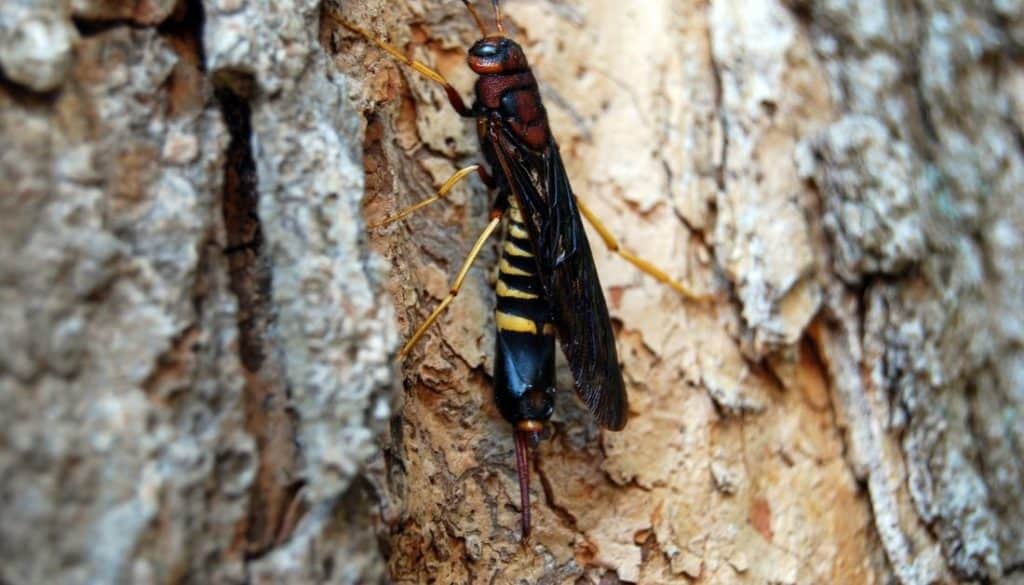Not all wood-boring insects are meant to destroy your home’s furniture or structural lumber.
Some wood bugs are harmless to you and your home.
In fact, these wood-eating bugs end up in your home accidentally.
Given a chance, they wouldn’t have been into your home in the first place.
The same goes with the wasp that eats wood – the horntail wasp, also known as timber wasp.
But why you shouldn’t bother about a wood burrowing wasp?
And why the horntail wasp isn’t a threat to your home?
This post answers both of your questions.
Plus, you’ll also get to know to what extent horntail wasps can damage the wood.
Let’s jump in.
Horntail Wasp Identification

Horntail wasps are common in California, Oregon, Washington, and Alaska.
What does a horntail wasp look like? They are quite easy to identify.
Horntail wasps, black to blackish-brown in color, are 1 inch long with two prominent antennae on their head.
It has a long cylindrical black lower abdomen which is marked with yellow stripes.
Just below the head, on it’s back, there’s a visible hump that looks a tough armor.
You’ll also see shades of bright yellow all over its legs and antennae. The wings cover its entire lower body, and they’re brownish with a rough surface.
And finally, there’s a tail, pointing out like a needle from it’s rear.
The female horntail wasp is slightly bigger than the male horntail wasp.
Female horntail wasps use the tail to lay eggs. They don’t use it to sting.
In fact, horntail wasps don’t bite or sting humans.
What Kind Of Wood Attracts The Wasp That Eats Wood – The Horntail Wasps?
Dying or dead conifer trees, like pine, attract adult horntail wasps.
Finished and dry wood like your furniture doesn’t attract horntail wasps.
Horntail wasps bore into the dying tree to lay eggs.
They prefer dead conifer trees to lay their eggs because the tree is weak, and it’s easy for them to bore into.
Life Cycle Of Horntail Wasps
The female horntail wasps bore up to 1 inch inside the dying or dead tree to lay eggs.
She can lay up to 200 eggs inside the wood. Then she exits the wood.
The eggs inside the wood take 3 to 4 weeks to hatch.
The larva, which comes out of the eggs after hatching, eats the wood from inside.
Adult horntail wasp doesn’t eat wood. It’s the larvae of the horntail wasps eat wood.
The larvae chew through the wood, parallelly, as long as it’s inside. It eats the sapwood (the softer wood) beneath the bark.
The larva continues eating the wood for over a year (for five years in cold climates) before it turns itself into a cocoon inside the wood known as a pupa.
After 5 to 6 weeks, the adult horntail larva comes out of the pupa.
Then it exits the wood by creating a half-inch hole.
Horntail Wasp Damage To Wood

Horntail wasp damage to wood is minimal. They don’t obliterate the wood like other wood-eating insects like termites and powderpost beetles.
When larva inside the finished furniture matures into an adult horntail wasp, it comes out by creating a hole on the wood from the inside.
And hence there’s occurrence of a few holes on the wood and you see these buzzing horntail wasps inside your home.
That’s the only damage that horn tail wasps can do to wood.
Why Horntail Wasps Aren’t A Threat To Your Home?
Adult horntail wasp can come out from places like your hardwood floor, headboard, and other wooden interiors if the larva is present in the wood piece.
But the best part is that you don’t need any pest control to get rid of horntail wasps.
Why?
Because once they leave the wood, they don’t come back. Which means that there’s no chance of re-infestation.
Female horntail wasps don’t lay eggs in the same piece of wood. And your furniture, being dry and finished, wouldn’t attract horntail wasps.
So, the only thing that you need to do is fill up the holes and polish the wood.
How To Get Rid Of Horntail Wasp’s Larvae?
If you want to get rid of the horntail wasp larvae, then vacuum fumigation is the only way.
But the major challenge lies in finding out if the furniture and the structural lumber has the horntail wasp larvae.
The horntail wasp larvae don’t turn the wood hollow from inside either. The larva eats the wood from inside only to a certain length which doesn’t weakens the wood.
The signs of infestation aren’t prominent too.
But if you can hear chewing sounds inside your home, then it’s a sign of a boring wood insect. That insect can be a powderpost beetle, old house wood borer, and even termites.
So, the best course of action is to take the help of a pest controller.


